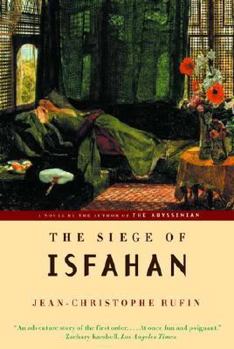Book Overview
Twenty years have passed since Jean-Baptiste Poncet's daring mission to the remote and exotic court of the King of Abyssinia. We find him now in Isfahan, capital of Persia, practicing medicine in the court of the Shah. In order to rescue his old friend Juremi, imprisoned in the Urals, Poncet travels in disguise to Russia, where he engages in a diplomatic duel of wits with Peter the Great. The friends, reunited, are captured by nomads and sold as slaves in Afghanistan. This is the beginning of Poncet's circuitous return to Isfahan, where his wife and daughter are trapped by a besieging army of the Afghan king, Mahmud.
Format:Paperback
Language:English
ISBN:0393323390
ISBN13:9780393323399
Release Date:August 2002
Publisher:W. W. Norton & Company
Length:382 Pages
Weight:0.80 lbs.
Dimensions:0.9" x 5.5" x 8.2"
Customer Reviews
2 ratings
Fine tale of adventure in Fareway Places.
Published by Thriftbooks.com User , 15 years ago
A read this novel in its original French. I absolutely loved it.Written in an extremely elegant language full of humour and genuine knowledge of the subject, it is a book that I simply could not put down. As a lover of history and good literature I find that both are entertwined here in a very successfull way. The novel offers us several interesting stories based on historical facts that are generally not known;de stories of Mr.de Maillet ,Cardinal Alberoni,the Swedish captives in Siberia a.o. Again the voyage of Poncet and his friends is filled with interesting details about the places they pass. The placid life -style in Ispahan is also depicted in detail.All through the novel we learn new aspects of the life and customs in very different areas and of very different people. The chapter on the Scythian Kurgans is also amusing and somewhat in the way of the opening of the Tomb of King TUT. I think this is one of those perfect books where eruditism is used in such a way that it becomes a pleasant read for everybody and still is more than a simple adventure book. Written with typical French finesse, I hope in translation it will not loose some of its original magic.
Exotic location, intrigue, reminiscent of G.A. Henty
Published by Thriftbooks.com User , 23 years ago
Rufin has given us an excellent piece of historical fiction reminiscent of the works of G.A. Henty and James Mitchner. As one who travelled overland from Mashad, Iran to Herat, Afghanistan in March 1971 and April 1972, while an American Peace Corps volunteer in Iran, (6/70-6/72), I can relate to the setting. Shah Tahmasp II was ruling as the last of the Safavid Shahs of Persia, when two Afghan 'sardars', Mahmud and Ashraf conquered Isfahan, the Safavid capital, as well as the earlier capital Qazvin. Mahmud and Ashraf were from the Hotaki (Ghilzai) dynasty. They imposed Sunni rule briefly on Shi'ia Persia. The book has much suspense and is historically accurate. An excellent read.





